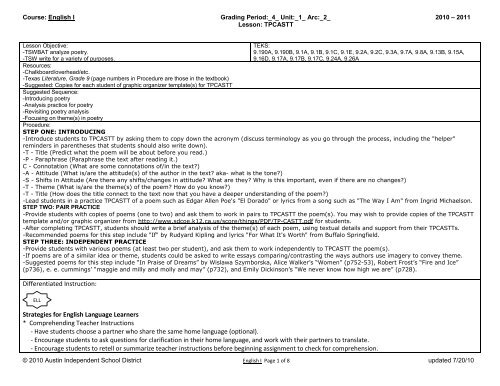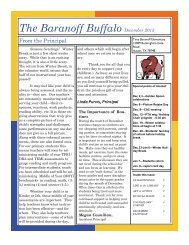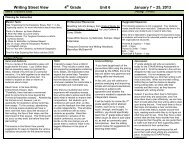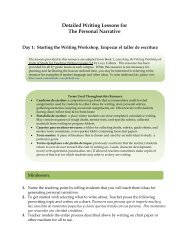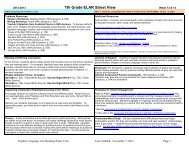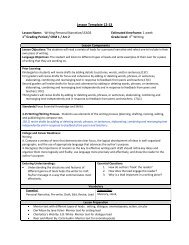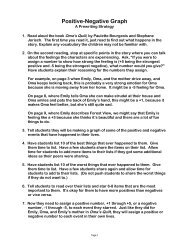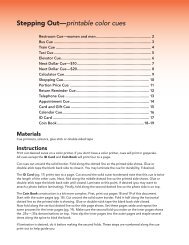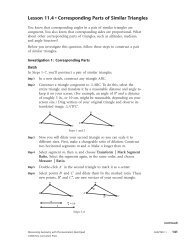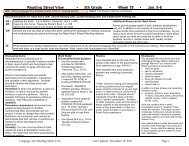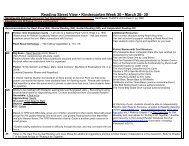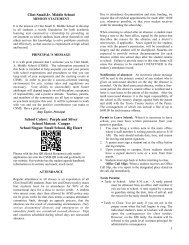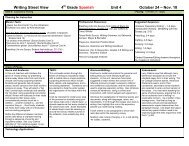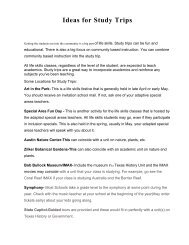TPCASTT Lesson
TPCASTT Lesson
TPCASTT Lesson
- No tags were found...
You also want an ePaper? Increase the reach of your titles
YUMPU automatically turns print PDFs into web optimized ePapers that Google loves.
Course: English I Grading Period:_4_ Unit:_1_ Arc:_2_ 2010 – 2011<strong>Lesson</strong>: <strong>TPCASTT</strong><strong>Lesson</strong> Objective:-TSWBAT analyze poetry.-TSW write for a variety of purposes.TEKS:9.190A, 9.190B, 9.1A, 9.1B, 9.1C, 9.1E, 9.2A, 9.2C, 9.3A, 9.7A, 9.8A, 9.13B, 9.15A,9.16D, 9.17A, 9.17B, 9.17C, 9.24A, 9.26AResources:-Chalkboard/overhead/etc.-Texas Literature, Grade 9 (page numbers in Procedure are those in the textbook)-Suggested: Copies for each student of graphic organizer template(s) for <strong>TPCASTT</strong>Suggested Sequence:-Introducing poetry-Analysis practice for poetry-Revisiting poetry analysis-Focusing on theme(s) in poetryProcedure:STEP ONE: INTRODUCING-Introduce students to <strong>TPCASTT</strong> by asking them to copy down the acronym (discuss terminology as you go through the process, including the "helper"reminders in parentheses that students should also write down).-T - Title (Predict what the poem will be about before you read.)-P - Paraphrase (Paraphrase the text after reading it.)C - Connotation (What are some connotations of/in the text?)-A - Attitude (What is/are the attitude(s) of the author in the text? aka- what is the tone?)-S - Shifts in Attitude (Are there any shifts/changes in attitude? What are they? Why is this important, even if there are no changes?)-T - Theme (What is/are the theme(s) of the poem? How do you know?)-T - Title (How does the title connect to the text now that you have a deeper understanding of the poem?)-Lead students in a practice <strong>TPCASTT</strong> of a poem such as Edgar Allen Poe's "El Dorado" or lyrics from a song such as "The Way I Am" from Ingrid Michaelson.STEP TWO: PAIR PRACTICE-Provide students with copies of poems (one to two) and ask them to work in pairs to <strong>TPCASTT</strong> the poem(s). You may wish to provide copies of the <strong>TPCASTT</strong>template and/or graphic organizer from http://www.sdcoe.k12.ca.us/score/things/PDF/TP-CASTT.pdf for students.-After completing <strong>TPCASTT</strong>, students should write a brief analysis of the theme(s) of each poem, using textual details and support from their <strong>TPCASTT</strong>s.-Recommended poems for this step include "If" by Rudyard Kipling and lyrics "For What It's Worth" from Buffalo Springfield.STEP THREE: INDEPENDENT PRACTICE-Provide students with various poems (at least two per student), and ask them to work independently to <strong>TPCASTT</strong> the poem(s).-If poems are of a similar idea or theme, students could be asked to write essays comparing/contrasting the ways authors use imagery to convey theme.-Suggested poems for this step include “In Praise of Dreams” by Wislawa Szymborska, Alice Walker’s “Women” (p752-53), Robert Frost’s “Fire and Ice”(p736), e. e. cummings’ “maggie and milly and molly and may” (p732), and Emily Dickinson’s “We never know how high we are” (p728).Differentiated Instruction:ELLStrategies for English Language Learners* Comprehending Teacher Instructions- Have students choose a partner who share the same home language (optional).- Encourage students to ask questions for clarification in their home language, and work with their partners to translate.- Encourage students to retell or summarize teacher instructions before beginning assignment to check for comprehension.© 2010 Austin Independent School District English I Page 1 of 8 updated 7/20/10
Course: English I Grading Period:_4_ Unit:_1_ Arc:_2_ 2010 – 2011<strong>Lesson</strong>: <strong>TPCASTT</strong>- If a student did not comprehend teacher instructions, encourage student partners to explain the step using mime to clarify the intention.- Communication Strategies, sentence starters to help students express themselves clearly, is found on page V39 in the English Learner’s Notebook.- Establish a purpose and goal for the lesson.STEP ONE: INTRODUCING- Optional: Prepare a <strong>TPCASTT</strong> worksheet for students to fill in.<strong>TPCASTT</strong>: Poem Analysis MethodTitleof poem meansParaphraseparts of the Poemin your own wordsConnotationof some of thewords – changingliteral meaning toimplied orassociated valuesAttitudeWhat is the attitudeof the author,characters oryourself?ShiftAt first we think orfeel one way – thenthere is a shift:identify the shiftsand explain them© 2010 Austin Independent School District English I Page 2 of 8 updated 7/20/10
Course: English I Grading Period:_4_ Unit:_1_ Arc:_2_ 2010 – 2011<strong>Lesson</strong>: <strong>TPCASTT</strong>v. on the hand for details using touch- Have students share details with the class from their Sensory Details Diagram.STEP THREE: INDEPENDENT PRACTICE• Provide students with various poems (at least two per student), and ask them to work independently to <strong>TPCASTT</strong> the poem(s).- Challenge students to complete a <strong>TPCASTT</strong> and a Sensory Details Diagram. Some students may work independently depending on their level.- Allow students to work with their partners.- Allow students to choose to either complete a poem or lyrics.• If poems are of a similar idea or theme, students could be asked to write essays comparing/contrasting the ways authors use imagery to convey theme.- This step is optional. If done, review the terms comparing and contrasting. Provide students with a Venn Diagram and review the writing process.- Allow students to work with their partners.• Suggested poems for this step include “In Praise of Dreams” by Wislawa Szymborska, Alice Walker’s “Women” (p752-53), Robert Frost’s “Fire and Ice”(p736), e. e. cummings’ “maggie and milly and molly and may” (p732), and Emily Dickinson’s “We never know how high we are” (p728).- Instruct students to place a note card under the first line of text. Tell them to use the note cards to help them follow along as you read.- Allow students time to discuss their prior knowledge and beliefs before they read the text.- Students have access to margin notes for unknown vocabulary during reading, and information from the reading paraphrased by students with teachersupport. Remind students that unfamiliar terms are explained in side notes. Teacher-Model the process of using side notes.- Depending on the comfort level of students, allow them to read aloud.- Selections are available in interactive format in the Enriched Online Student Edition, www.PHLitOnline.com, which includes a thematically related videowith writing prompt and an interactive graphic organizer.- Selections are available on the Hear It! Audio CD.TIPS:‣ Teachers can model thought processes and strategies by thinking aloud. This modeling can move toward increased independence byprogressing to students thinking along with the teacher and eventually thinking on their own.‣ All students must be accountable for what they have learned. Address assessment at the beginning of a new lesson so that students understandwhat is expected of them.‣ At the end of the lesson, evaluate which teaching strategies and techniques were successful and which weren’t. Track your results and note anypatterns that emerge for future reference. This technique can help you prepare for your next lesson and identify the best methods for teachingELLs.‣ Hard copy of teacher notes and a completed example of the lesson should be available for students to view; if needed.ELPS 1 (A)(B)(D)(E)(F); 2 (B)(C)(D)(H)(I); 3 (A)(C)(D)(E)(I); 4 (A)(D)(E)(F)(G)(I)(J); 5 (B)(C)(F)© 2010 Austin Independent School District English I Page 4 of 8 updated 7/20/10
Course: English I Grading Period:_4_ Unit:_1_ Arc:_2_ 2010 – 2011<strong>Lesson</strong>: <strong>TPCASTT</strong>SNSStrategies for Special Needs Students* Comprehending Teacher Instructions- Encourage students to ask questions for clarification.- Encourage students to retell or summarize teacher instructions before beginning assignment to check for comprehension.- If a student did not comprehend teacher instructions, provide a hard copy of instructions and clarify on-on-one.- Establish a purpose and goal for the lesson.STEP ONE: INTRODUCING- Optional: Prepare a <strong>TPCASTT</strong> worksheet for students to fill in.<strong>TPCASTT</strong>: Poem Analysis MethodTitleof poem meansParaphraseparts of the Poemin your own wordsConnotationof some of thewords – changingliteral meaning toimplied orassociated valuesAttitudeWhat is the attitudeof the author,characters oryourself?Shift© 2010 Austin Independent School District English I Page 5 of 8 updated 7/20/10
Course: English I Grading Period:_4_ Unit:_1_ Arc:_2_ 2010 – 2011<strong>Lesson</strong>: <strong>TPCASTT</strong>At first we think orfeel one way – thenthere is a shift:identify the shiftsand explain themTitlerevisitedAny new insightson meaning orsignificance oftitle?ThemeDetermine what thepoet is saying?• Lead students in a practice <strong>TPCASTT</strong> of a poem such as Edgar Allen Poe's "El Dorado" or lyrics from a song such as "The Way I Am" from IngridMichaelson.- Teacher-Model what is expected of students to produce.- Optional: Have students choose a song and print the lyrics. Read lyrics as a class, listen to song, and complete <strong>TPCASTT</strong> as a class. Imagery can beadded along with this part of the lesson.STEP TWO: PAIR PRACTICE• Provide students with copies of poems (one to two) and ask them to work in pairs to <strong>TPCASTT</strong> the poem(s). You may wish to provide copies of the<strong>TPCASTT</strong> template and/or graphic organizer from http://www.sdcoe.k12.ca.us/score/things/PDF/TP-CASTT.pdf for students.- Start students with one poem after they have reviewed an example of a completed <strong>TPCASTT</strong>.- Allow students to work with their partners.• Recommended poems for this step include "If" by Rudyard Kipling and lyrics "For What It's Worth" from Buffalo Springfield.- Allow students to choose a poem or lyrics for their <strong>TPCASTT</strong>. If students choose a song, have them listen to the song after they have completed the<strong>TPCASTT</strong>.- OPTIONAL: Challenge students to complete a Sensory Appeals Diagram. For example, students may choose a poem or lyrics. Explain that every timethey read a description that helps them to actually see, hear, taste, smell, or feel what is being described, they must take a Post-it note and attach it tothe quote on the page. After they have identified all the sensory details flagged by the Post-it notes, then they need to copy the actual detail from theexcerpt onto the Post-it. Upon completion, they should have a collection of Post-it notes. Distribute the Sensory Details Diagram printable to each groupor individual students. You may print Sensory Details Diagram at http://teacher.scholastic.com/lessonplans/pdf/june05/sensory.pdfInstruct the groups to review each Post-it with the sensory detail and do one of two things:a. Discuss the quote as literal and discard the Post-it note.OR© 2010 Austin Independent School District English I Page 6 of 8 updated 7/20/10
Course: English I Grading Period:_4_ Unit:_1_ Arc:_2_ 2010 – 2011<strong>Lesson</strong>: <strong>TPCASTT</strong>b. Decide the detail is figurative and place the Post-it on the following areas of the Sensory Details Diagram:i. on the eyes for details using sightii. on the ears for details using soundiii. on the nose for details using smelliv. on the tongue for details using tastev. on the hand for details using touch- Have students share details with the class from their Sensory Details Diagram.STEP THREE: INDEPENDENT PRACTICE• Provide students with various poems (at least two per student), and ask them to work independently to <strong>TPCASTT</strong> the poem(s).- Challenge students to complete a <strong>TPCASTT</strong> and a Sensory Details Diagram. Some students may work independently depending on their level.- Allow students to work with their partners.- Allow students to choose to either complete a poem or lyrics.• If poems are of a similar idea or theme, students could be asked to write essays comparing/contrasting the ways authors use imagery to convey theme.- This step is optional. If done, review the terms comparing and contrasting. Provide students with a Venn Diagram and review the writing process.- Allow students to work with their partners.• Suggested poems for this step include “In Praise of Dreams” by Wislawa Szymborska, Alice Walker’s “Women” (p752-53), Robert Frost’s “Fire and Ice”(p736), e. e. cummings’ “maggie and milly and molly and may” (p732), and Emily Dickinson’s “We never know how high we are” (p728).- Instruct students to place a note card under the first line of text. Tell them to use the note cards to help them follow along as you read.- Allow students time to discuss their prior knowledge and beliefs before they read the text.- Students have access to margin notes for unknown vocabulary during reading, and information from the reading paraphrased by students with teachersupport. Remind students that unfamiliar terms are explained in side notes. Teacher-Model the process of using side notes.- Depending on the comfort level of students, allow them to read aloud.- Selections are available in interactive format in the Enriched Online Student Edition, www.PHLitOnline.com, which includes a thematically related videowith writing prompt and an interactive graphic organizer.- Selections are available on the Hear It! Audio CD.• Allow students extra time to complete assignment.• Hard copy of notes and completed teacher example of lesson available; if needed.• Verbal and visual reminders to stay focused on lesson.• The Special Education Department located on your campus is a great resource or feel free to contact me through campus email. My information isbelow.Duration: one to two class periodsEvidence of Learning/Assessment/Student Work Products:-Discussion/Participation-Notes-<strong>TPCASTT</strong> adequate/accurate completions: pairs & individual work-Pair written analysis of theme(s)© 2010 Austin Independent School District English I Page 7 of 8 updated 7/20/10
Course: English I Grading Period:_4_ Unit:_1_ Arc:_2_ 2010 – 2011<strong>Lesson</strong>: <strong>TPCASTT</strong>-Individual essaysRelated Readings:-A handout version of <strong>TPCASTT</strong>, with instructions, etc.:http://www.sdcoe.k12.ca.us/score/things/PDF/TP-CASTT.pdf-A <strong>TPCASTT</strong> template:http://skyview.vansd.org/bquestad/cw/poetry/<strong>TPCASTT</strong>%20Template.htm-<strong>TPCASTT</strong>, from Houston ISD:http://hs.houstonisd.org/ReaganHS/Academies/Resources/<strong>TPCASTT</strong>.htm-“In Praise of Dreams”- there are several translations available from differentsources… this site also includes journal prompts to go along with the poem:http://www.journaltherapy.com/poem/archive/2002/poem0207.htm<strong>TPCASTT</strong> and other poetry analysis strategies:http://skyview.vansd.org/bquestad/cw/poetry/<strong>TPCASTT</strong>%20Template.htmSensory Details Diagram <strong>Lesson</strong>:http://www2.scholastic.com/browse/lessonplan.jsp?id=137<strong>Lesson</strong> Author/email addressAshley Robinson/ jrobins1@austinisd.orgELLSNS: valerie.pannell@austinisd.org© 2010 Austin Independent School District English I Page 8 of 8 updated 7/20/10


